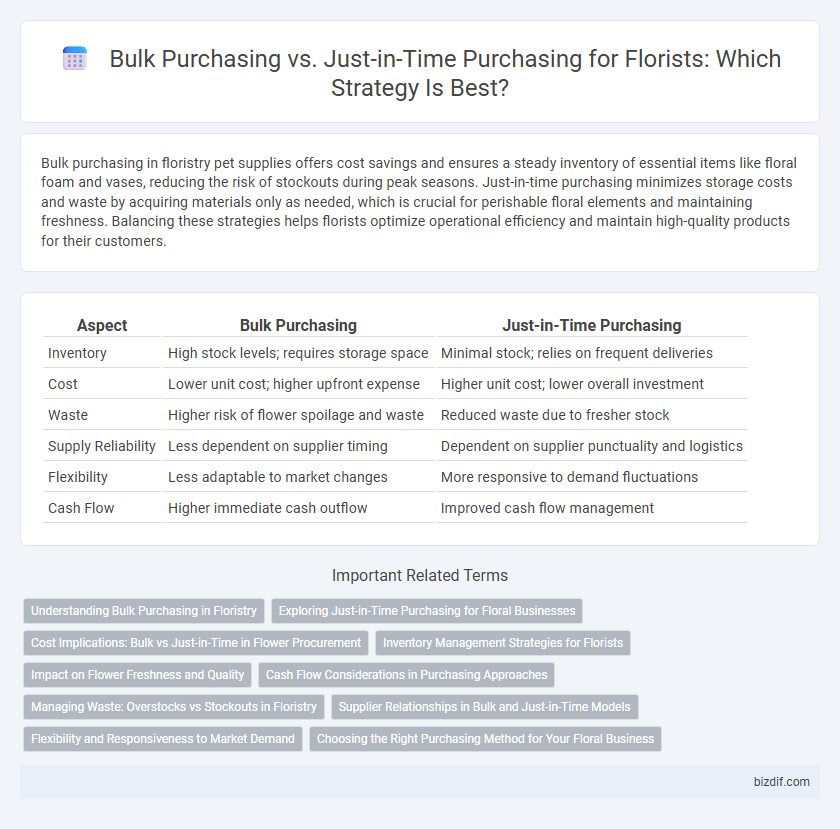Bulk purchasing in floristry pet supplies offers cost savings and ensures a steady inventory of essential items like floral foam and vases, reducing the risk of stockouts during peak seasons. Just-in-time purchasing minimizes storage costs and waste by acquiring materials only as needed, which is crucial for perishable floral elements and maintaining freshness. Balancing these strategies helps florists optimize operational efficiency and maintain high-quality products for their customers.
Table of Comparison
| Aspect | Bulk Purchasing | Just-in-Time Purchasing |
|---|---|---|
| Inventory | High stock levels; requires storage space | Minimal stock; relies on frequent deliveries |
| Cost | Lower unit cost; higher upfront expense | Higher unit cost; lower overall investment |
| Waste | Higher risk of flower spoilage and waste | Reduced waste due to fresher stock |
| Supply Reliability | Less dependent on supplier timing | Dependent on supplier punctuality and logistics |
| Flexibility | Less adaptable to market changes | More responsive to demand fluctuations |
| Cash Flow | Higher immediate cash outflow | Improved cash flow management |
Understanding Bulk Purchasing in Floristry
Bulk purchasing in floristry allows florists to acquire large quantities of flowers and floral supplies at lower prices, reducing per-unit costs and ensuring stock availability for peak seasons or large events. Proper storage and inventory management are critical to prevent flower spoilage and maintain freshness when buying in bulk. This strategy enhances cost efficiency and supports continuous business operations by mitigating supply chain disruptions.
Exploring Just-in-Time Purchasing for Floral Businesses
Just-in-time purchasing in floral businesses minimizes inventory holding costs by synchronizing flower orders with demand, reducing waste due to perishability. This strategy enhances freshness and extends shelf life, crucial for maintaining the aesthetic appeal of blooms. Implementing precise demand forecasting and reliable supplier relationships is essential for the success of just-in-time purchasing in the floristry industry.
Cost Implications: Bulk vs Just-in-Time in Flower Procurement
Bulk purchasing in floristry significantly lowers per-unit costs by securing large quantities of flowers at discounted rates, reducing overall expenditure. Just-in-time purchasing, while minimizing storage and waste, often incurs higher prices due to smaller order volumes and expedited delivery fees. Balancing these cost implications is crucial for florists aiming to optimize budget efficiency without compromising flower freshness.
Inventory Management Strategies for Florists
Bulk purchasing enables florists to secure lower prices on large quantities of flowers, reducing overall costs but requiring effective storage solutions to maintain freshness. Just-in-time purchasing minimizes inventory holding by ordering flowers closer to delivery dates, which helps prevent waste but demands precise supplier coordination and forecasting. Balancing these inventory management strategies is essential for florists to optimize cash flow and meet customer demand without compromising floral quality.
Impact on Flower Freshness and Quality
Bulk purchasing in floristry often leads to longer storage times, which can compromise flower freshness and reduce overall quality due to extended exposure to handling and suboptimal storage conditions. Just-in-time purchasing aligns flower delivery with demand, ensuring blooms arrive fresher and maintaining optimal color, fragrance, and vase life. Maintaining freshness through just-in-time purchasing supports higher customer satisfaction and reduces waste from wilting or discarded flowers.
Cash Flow Considerations in Purchasing Approaches
Bulk purchasing in floristry locks in lower per-unit prices and reduces order frequency, enhancing cost predictability but tying up significant cash in inventory. Just-in-time purchasing minimizes inventory holding costs and improves cash flow flexibility by ordering flowers only as needed, though it risks higher prices and supply chain disruptions. Effective cash flow management requires balancing bulk discounts with the financial agility provided by just-in-time procurement strategies.
Managing Waste: Overstocks vs Stockouts in Floristry
Effective waste management in floristry hinges on balancing bulk purchasing and just-in-time purchasing to minimize overstocks and stockouts. Bulk purchasing often leads to excess inventory that risks wilting and disposal, increasing floral waste and costs. Just-in-time purchasing reduces inventory levels, ensuring fresher stock and less waste but requires precise demand forecasting to avoid costly stockouts that disrupt customer orders.
Supplier Relationships in Bulk and Just-in-Time Models
Strong supplier relationships are vital in both bulk and just-in-time purchasing models within floristry, yet they serve different operational needs. Bulk purchasing demands reliable suppliers capable of consistent large-volume deliveries to ensure stock availability and cost savings, while just-in-time purchasing relies on agile suppliers who can provide fresh flowers promptly, minimizing inventory and waste. Effective communication and trust between florists and suppliers enhance product quality, delivery schedules, and overall supply chain efficiency in either model.
Flexibility and Responsiveness to Market Demand
Bulk purchasing in floristry offers cost savings and ensures a steady supply of flowers but limits flexibility due to large inventory and risk of spoilage. Just-in-time purchasing enhances responsiveness to market demand by allowing florists to order fresh flowers as needed, reducing waste and adapting quickly to changing trends. Efficient inventory management systems support just-in-time strategies, optimizing floral freshness and customer satisfaction.
Choosing the Right Purchasing Method for Your Floral Business
Bulk purchasing offers cost savings and inventory stability for floral businesses with consistent demand, reducing per-unit prices and minimizing supply uncertainty. Just-in-time purchasing enhances freshness and reduces storage costs by aligning flower orders closely with customer demand, ideal for businesses prioritizing flower quality and minimal waste. Evaluating sales patterns, storage capacity, and supplier reliability helps florists select a purchasing method that maximizes profit margins and meets customer satisfaction.
Bulk Purchasing vs Just-in-Time Purchasing Infographic

 bizdif.com
bizdif.com